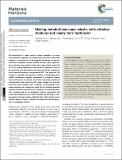Making metals linear super-elastic with ultralow modulus and nearly zero hysteresis
Author(s)
Zhu, Jiaming; Gao, Yipeng; Li, Ju; Zhang, Tong-Yi; Wang, Yunzhi; Wang, Dong, 1975-; ... Show more Show less
Downloadc8mh01141a.pdf (2.850Mb)
PUBLISHER_CC
Publisher with Creative Commons License
Creative Commons Attribution
Terms of use
Metadata
Show full item recordAbstract
We demonstrate a novel materials design approach to achieve unprecedented properties by utilizing nanoscale chemo-mechanical coupling. In particular, by using computer simulations we demon- strate how to engineer ultralow modulus (12 GPa), nearly hysteresis- free, and linear super-elastic metals with a giant elastic strain limit (2.7%) by creating appropriate concentration modulations (CMs) at the nanoscale in the parent phase and by pre-straining to regulate the stress-induced martensitic transformation (MT). The nanoscale CMs created via spinodal decomposition produce corresponding phase stability modulations, suppress autocatalysis in nucleation, impose nano-confinements on growth, and hinder long-range ordering of transformation strain during the MT, which changes the otherwise sharp first-order transition into a smeared, macroscopically conti- nuous transition over a large stress range. The pre-straining generates retained martensitic particles that are stable at the test temperature after unloading and act as operational nuclei in subsequent load cycles, eliminating the stress–strain hysteresis and offering an ultra- low apparent Young’s modulus. Materials with a high strength and an ultralow apparent Young’s modulus have great potential for applica- tion in orthopaedic implants.
Date issued
2018-12Department
Massachusetts Institute of Technology. Department of Mechanical Engineering; Massachusetts Institute of Technology. Department of Nuclear Science and EngineeringJournal
Materials Horizons
Publisher
Royal Society of Chemistry (RSC)
Citation
Zhu, Jiaming, Yipeng Gao, Dong Wang, Ju Li, Tong-Yi Zhang, and Yunzhi Wang. “Making Metals Linear Super-Elastic with Ultralow Modulus and Nearly Zero Hysteresis.” Materials Horizons (2019).
Version: Final published version
ISSN
2051-6347
2051-6355